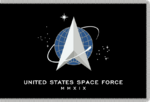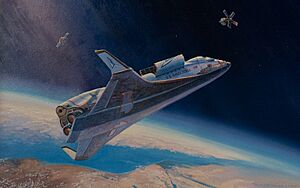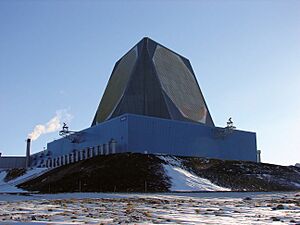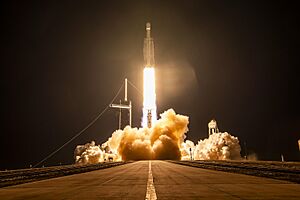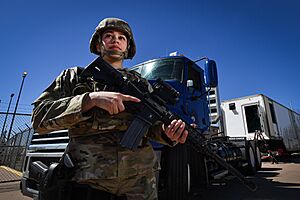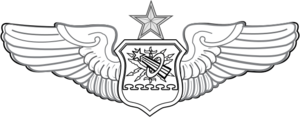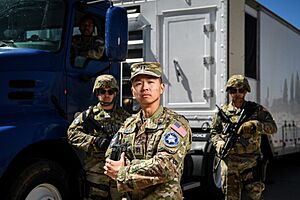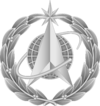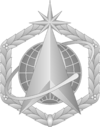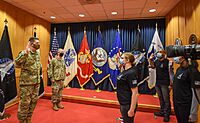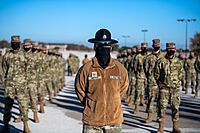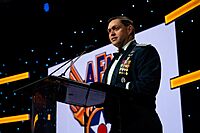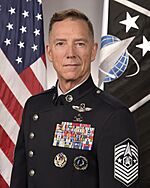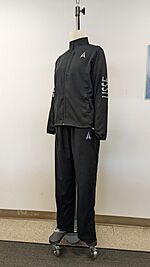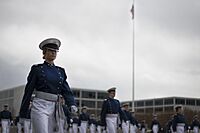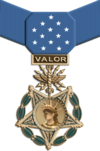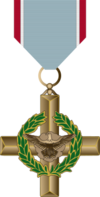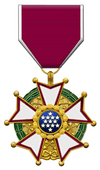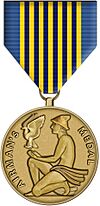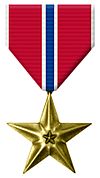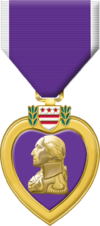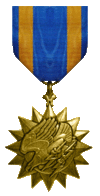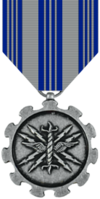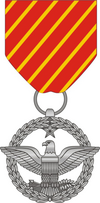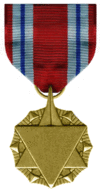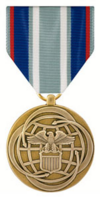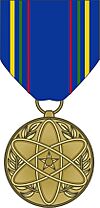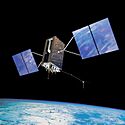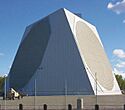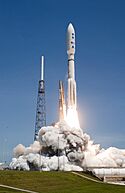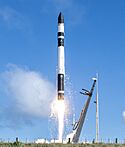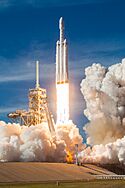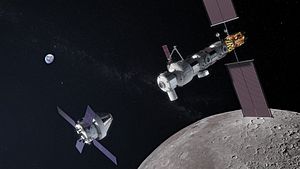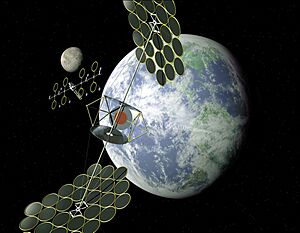United States Space Force facts for kids
Quick facts for kids United States Space Force |
|
|---|---|
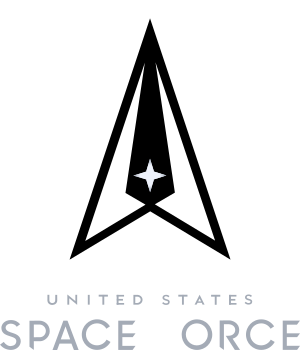 Space Force Delta |
|
| Founded | 20 December 2019 |
| Type | Space force |
| Size | 9,400 military personnel |
| Part of | United States Armed Forces Department of the Air Force |
| Headquarters | The Pentagon Arlington County, Virginia, U.S. |
| Motto(s) |
|
| March | "Semper Supra" |
| Anniversaries | 20 December |
| Equipment | See spacecraft and space systems |
| Engagements |
As Air Force Space Command
As U.S. Space Force
|
| Commanders | |
| Commander-in-Chief | |
| Secretary of Defense | |
| Secretary of the Air Force | |
| Chief of Space Operations | |
| Vice Chief of Space Operations | |
| Chief Master Sergeant of the Space Force | |
| Insignia | |
| Flag | |
| Seal | |
| Emblem | |
The United States Space Force (USSF) is a branch of the United States Armed Forces. It is the part of the U.S. military that focuses on space. It is one of only two independent space forces in the world.
The Space Force started from military space programs in the Air Force, Army, and Navy during the Cold War. U.S. military space forces first helped in combat during the Vietnam War. They have been part of every U.S. military operation since then. The Persian Gulf War was even called the "first space war" because space operations were so important. The idea of a U.S. Space Force became more serious in the 1980s.
Talks about creating a Space Force began in the 1990s and early 2000s. The idea came back in the late 2010s because other countries were developing their military space programs. This led to the Space Force being created on December 20, 2019.
The Space Force is part of the Department of the Air Force, just like the U.S. Air Force. The Department of the Air Force is led by the Secretary of the Air Force. The U.S. Space Force itself is led by the Chief of Space Operations.
Contents
What the Space Force Does
Secure our Nation's interests in, from, and to space.
The Space Force has important jobs to do in space. These jobs are listed in a law called the United States Space Force Act. The Space Force is set up to:
- Help the United States operate freely in, from, and to space.
- Carry out space operations.
- Protect U.S. interests in space.
The Department of Defense also says the Space Force must:
- Provide freedom to operate in space.
- Perform space operations quickly and continuously.
- Protect U.S. interests in space.
- Stop attacks in, from, and to space.
- Conduct space operations.
The Space Force divides its work into three main parts:
- Space Superiority (in space)
- Global Mission Operations (from space)
- Assured Space Access (to space)
Space Superiority
Space superiority means protecting our spacecraft from threats. It also means stopping attacks that use enemy spacecraft. The Space Force needs to control space. This way, the U.S. can keep using its spacecraft. It can also stop enemies from using their spacecraft or space tools.
Missions that help with space superiority include:
- Orbital warfare: Fighting in space.
- Electromagnetic warfare: Using radio waves to control or stop signals.
- Space battle management: Directing space operations.
Global Mission Operations
Global mission operations connect different military actions around the world. Through space, the U.S. military and its friends can see, talk, and find their way. These operations also protect U.S. forces on Earth. They give early warnings of incoming missiles or other attacks. The Space Force says these operations help the rest of the U.S. military defend land, air, and sea.
Missions that support global operations include:
- Missile warning: Spotting missiles early.
- Satellite communications: Talking through satellites.
- Positioning, navigation, and timing: Helping with GPS and accurate time.
Assured Space Access
Assured space access means the Space Force can launch and keep equipment in space. This includes launching rockets. It also means guiding spacecraft to avoid space junk. The Space Force needs to be able to launch and operate in space all the time.
Missions supporting space access include:
- Launch: Sending things into space.
- Range control: Managing launch areas.
- Cyber: Protecting computer systems.
- Space domain awareness: Knowing what is happening in space.
How the Space Force is Organized

The Space Force has a main headquarters that leads the force. It also has field commands that train and equip its members, called Guardians. Deltas support these commands and focus on specific missions. Squadrons specialize in things like buying equipment, cyber operations, and space operations.
Headquarters Space Force
The Space Force is led by the Chief of Space Operations. This is a four-star general who advises the Secretary of the Air Force. The Space Force and the U.S. Air Force together form the Department of the Air Force. This is similar to how the U.S. Navy and U.S. Marine Corps form the Department of the Navy.
Commands and Units
The Space Force has three main field commands. These commands are built for specific tasks. They organize, train, and equip Guardians. There are also "Component field commands" that help combine space forces into larger military plans. "Direct reporting units" are places for new ideas and special knowledge.
| Field Command | Mission | Headquarters | |
|---|---|---|---|
| Space Operations Command (SpOC) | Creates and supports space warfighting abilities | Peterson SFB, Colorado | |
| Space Systems Command (SSC) | Develops and provides space tools | Los Angeles AFB, California | |
| Space Training and Readiness Command (STARCOM) | Trains Guardians for competition and conflict | Peterson SFB, Colorado | |
Bases
The Space Force headquarters is in Washington, D.C. But its other parts are all over the United States and in other countries. As of 2024, they are in 18 states and territories, and at 46 bases.
People and Culture
Symbols of the Space Force
The Delta Symbol
The delta symbol is very important to the Space Force. It comes from the rocket equation where "Delta v" means change in speed. Since the 20th century, the delta has looked like a rocket or an arrow. The United States Army Air Forces used it in 1940.
After World War II, the delta was used in space programs. It appeared on the U.S. Air Force-NASA X-15 aircraft. In 1962, the Air Force Ballistic Missile Division used the delta. It showed the Air Force's push into space and the rockets used to launch satellites. This delta later became the main shape for the Space Force's seal and logo.
Guardians
Members of the Space Force are called Guardians. This is like how U.S. Marine Corps members are called Marines. The name "Guardian" comes from the Air Force Space Command's old motto: "Guardians of the High Frontier." Before December 2020, they were called "space professionals."
Semper Supra
The Space Force's motto is Semper Supra. This means "Always Above." It is similar to the mottos of the Marine Corps (Semper Fidelis – Always Faithful) and Coast Guard (Semper Paratus – Always Ready). The Space Force's official song is also named "Semper Supra."
Jobs and Badges
|
Space Operations |
Intelligence |
Cyberspace Operations |
Acquisition and Engineering |
|---|---|---|---|
| Officers | |||
|
|
|
|
| Enlisted Members | |||
|
|
|
|
Space operators are the largest group in the Space Force. They lead space operations. Space operations officers (13S) plan and lead space combat. This includes orbital warfare and space access. Enlisted Space Systems Operators (5S) carry out these operations. They earn the Space Operations Badge after training.
The Space Force has two astronauts (13A). They are Space Force officers working with NASA. They fly spacecraft and work on the International Space Station. They also help the Department of Defense with spaceflight. After a spaceflight, they get the observer badge with an astronaut rating.
Intelligence officers (14N) lead the Space Force's intelligence work. They gather and analyze information. They lead enlisted analysts who specialize in different types of intelligence. These Guardians earn their intelligence badge after training.

Cyberspace effects operations officers (17S) manage cyber weapons and satellite communication systems. They lead enlisted Cyberspace Operations Guardians. They earn the cyberspace operator badge after training.
Acquisition and engineering are jobs only for officers. Engineers (62E) work on things like aeronautical and computer systems. Acquisition managers (63A) handle how the Space Force buys new equipment.
Spacepower Disciplines
The U.S. Space Force has seven main areas of expertise:
- Orbital Warfare: Knowing how to move and fight in orbit. This helps keep space free for U.S. forces.
- Space Electromagnetic Warfare: Understanding and using radio waves. This can stop enemies from using their signals.
- Space Battle Management: Making quick decisions in space. This helps protect missions and stop enemies.
- Space Access and Sustainment: Knowing how to launch and keep things working in space. This ensures continuous space operations.
- Military Intelligence: Using information to understand threats. This helps defend space.
- Engineering and Acquisition: Making sure the Space Force has the best tools. This involves working with other groups and companies.
- Cyber Operations: Protecting the computer networks that space operations rely on. This includes cyber defense and future attack abilities.
Ranks
Officers
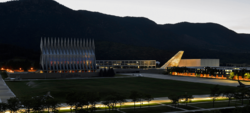
Officers are the leaders in the Space Force. They plan missions and manage people. Officers can join after graduating from the United States Air Force Academy, Air Force Reserve Officer Training Corps, or Air Force Officer Training School.
The U.S. Air Force Academy is a top place for Space Force officers to start. About 10% of each class becomes Space Force officers. The Academy has a long history with space, offering space majors and courses. In April 2020, 86 officers from the Academy joined the Space Force.
The Air Force Reserve Officer Training Corps is available at many colleges. It also commissions officers into the Space Force. The Air Force Officer Training School is another way to become an officer. The first all-Space Force group from this school graduated in March 2023.
Space Force officers continue their education at places like Johns Hopkins University. They also train at the 319th Combat Training Squadron and National Security Space Institute.
| US DoD pay grade |
O-10 | O-9 | O-8 | O-7 | O-6 | O-5 | O-4 | O-3 | O-2 | O-1 | Officer candidate |
|---|---|---|---|---|---|---|---|---|---|---|---|
| NATO code | OF-9 | OF-8 | OF-7 | OF-6 | OF-5 | OF-4 | OF-3 | OF-2 | OF-1 | OF(D) | |
| Insignia | Various insignia | ||||||||||
| Service dress uniform (Class A) |  |
 |
 |
 |
 |
 |
 |
 |
 |
 |
 |
| Title | General | Lieutenant general | Major general | Brigadier general | Colonel | Lieutenant colonel | Major | Captain | First lieutenant | Second lieutenant | Cadet / Officer trainee |
| Abbreviation | Gen | Lt Gen | Maj Gen | Brig Gen | Col | Lt Col | Maj | Capt | 1st Lt | 2d Lt | Cdt / OT |
Enlisted Members
Enlisted members support and participate in operations. They complete Basic Military Training at Joint Base San Antonio. This training is similar to the Air Force's, but with Space Force-specific lessons. The first enlisted members joined the Space Force in October 2020. In May 2022, the Space Force started its own training for Guardians.
Enlisted members can earn an associate degree from the Community College of the Air Force. They also get professional military education at the Forrest L. Vosler Non-Commissioned Officer Academy.
The Space Force's enlisted ranks use a hexagon shape. This shows that it is the sixth military service. The horizontal stripes for Specialists are called "Vandenberg stripes." The delta symbol represents the Space Force. The specialist stripes show a strong foundation of skills. Higher ranks have traditional chevrons and symbols like the "Delta, Globe, and Orbit." These show their higher responsibilities.
| US DoD pay grade | Special | E-9 | E-8 | E-7 | E-6 | E-5 | E-4 | E-3 | E-2 | E-1 | |
|---|---|---|---|---|---|---|---|---|---|---|---|
| NATO code | OR-9 | OR-8 | OR-7 | OR-6 | OR-5 | OR-4 | OR-3 | OR-2 | OR-1 | ||
| Insignia |  |
 |
 |
 |
 |
 |
 |
 |
 |
 |
 |
| Title | Senior Enlisted Advisor to the Chairman | Chief Master Sergeant of the Space Force | Chief master sergeant | Senior master sergeant | Master sergeant | Technical sergeant | Sergeant | Specialist 4 | Specialist 3 | Specialist 2 | Specialist 1 |
| Abbreviation | SEAC | CMSSF | CMSgt | SMSgt | MSgt | TSgt | Sgt | Spc4 | Spc3 | Spc2 | Spc1 |
Uniforms
| Air Force Mess Dress Uniform (interim) | Service Dress Uniform Class "A" |
Service Uniform Class "B" |
Air Force Service Dress Uniform (interim) | OCP Uniform | Physical Training Uniform | |
|---|---|---|---|---|---|---|
The Space Force is creating its own unique uniforms. For now, Guardians wear Air Force uniforms with some changes. These changes include Space Force symbols and buttons. They also wear Space Force rank insignia and hexagonal nametags.
The main Space Force uniform is the OCP Uniform. It uses "space blue" thread for ranks and badges. It also has a full-color flag on the left sleeve.
The Space Force showed its new blue and gray service dress uniform in 2021. The dark blue comes from the Space Force seal and represents space. The six buttons show it is the sixth armed service. The Physical Training Uniform was shown in September 2021. These new uniforms are expected to be available in the next few years.
Space Force cadets at the Air Force Academy wear similar uniforms to Air Force cadets. However, in their parade uniforms, they wear a special platinum sash.
Awards and Decorations
The Space Force and the United States Air Force share many of the same awards. In November 2020, many Air Force awards were renamed to include "Air and Space" to include the Space Force.
The Space Force is also creating its own Good Conduct Medal for enlisted members. This was approved in August 2023. There are also talks about changing the Airman's Medal to the Air and Space Force Medal.
| Arctic "A" Device | Arrowhead Device | Combat "C" Device | Oak leaf cluster | Remote "R" Device | Service Star | Valor "V" Device | ||
|---|---|---|---|---|---|---|---|---|
Decorations
| Medal of Honor | Air Force Cross | Distinguished Service Medal | Silver Star Medal | Legion of Merit | Distinguished Flying Cross | Airman's Medal | Bronze Star Medal | Purple Heart | Meritorious Service Medal | Air Medal | Aerial Achievement Medal | Air and Space Commendation Medal | Air and Space Achievement Medal |
|---|---|---|---|---|---|---|---|---|---|---|---|---|---|
 |
|||||||||||||
Unit Awards
| Presidential Unit Citation | Gallant Unit Citation | Meritorious Unit Award | Air and Space Outstanding Unit Award | Air and Space Organizational Excellence Award |
|---|---|---|---|---|
Campaign and Service Awards
| Combat Action Medal | Combat Readiness Medal | Space Force Good Conduct Medal | Air and Space Recognition Ribbon | Remote Combat Effects Campaign Medal | Air and Space Campaign Medal | Nuclear Deterrence Operations Service Medal | Air and Space Overseas Service Ribbon (Short Tour) | Air and Space Overseas Service Ribbon (Long Tour) | Air and Space Expeditionary Service Ribbon | Air and Space Longevity Service Award | Developmental Special Duty Ribbon | Air Force Enlisted Professional Military Education Graduate Ribbon | Basic Military Training Honor Graduate Ribbon | Small Arms Expert Marksmanship Ribbon | Air and Space Training Ribbon | |
|---|---|---|---|---|---|---|---|---|---|---|---|---|---|---|---|---|
Spacecraft and Systems
Spacecraft
| Name | Spacecraft image | Mission | Operator | Number |
|---|---|---|---|---|
| Advanced Extremely High Frequency (AEHF) | Satellite communications | Space Delta 8 | 6 | |
| Defense Meteorological Satellite Program (DMSP) | Environmental monitoring | Mission Delta 2 | 4 | |
| Global Positioning System (GPS) | Positioning, navigation, and timing | Mission Delta 31 | 32 | |
| Geosynchronous Space Situational Awareness Program (GSSAP) | Space surveillance | Space Delta 9 | 6 | |
| Space-Based Infrared System (SBIRS) | Missile warning Missile defense Battlespace awareness Technical intelligence |
Mission Delta 4 | 7 | |
| X-37B Orbital Test Vehicle | Orbital test spaceplane | Space Delta 9 | 2 |
Space Systems
| Name | Space system image | Mission | Operator |
|---|---|---|---|
| AN/FPS-85 | Space surveillance | Mission Delta 2 | |
| Cobra Dane | Missile defense Space surveillance |
Mission Delta 4 | |
| Ground-Based Electro-Optical Deep Space Surveillance (GEODSS) | Space surveillance | Mission Delta 2 | |
| Satellite Control Network (SCN) | Ground station | Space Delta 6 | |
| Space Fence | Space surveillance | Mission Delta 2 | |
| Upgraded Early Warning Radar (UEWR) | Missile warning Missile defense Space surveillance |
Mission Delta 4 |
Space Launch Vehicles
| Name | Space launch vehicle image | Class | Contractor |
|---|---|---|---|
| Atlas V | Medium-lift launch vehicle | United Launch Alliance | |
| Electron | Small-lift launch vehicle | Rocket Lab | |
| Falcon 9 | Medium to Heavy-lift launch vehicle | SpaceX | |
| Falcon Heavy | Heavy to Super heavy-lift launch vehicle | SpaceX | |
| Pegasus | Air launched small-lift launch vehicle | Northrop Grumman |
Future Plans and Budget
| United States Space Force Budget | 2020 | 2021 | 2022 | 2023 (Enacted) | 2024 |
|---|---|---|---|---|---|
| Operation & Maintenance | $40,000,000 | $2,492,114,000 | $3,611,012,000 | $4,086,883,000 | TBA |
| Procurement | — | $2,310,994,000 | $2,787,354,000 | $4,462,188,000 | $3,752,194,000 |
| Research, Development, Test & Evaluation | — | $10,540,069,000 | $11,794,566,000 | $16,631,377,000 | $19,551,449,000 |
| Military Personnel | — | — | — | $1,109,400,000 | TBA |
| Total | $40,000,000 | $15,343,177,000 | $18,192,932,000 | $26,289,848,000 | TBA |
The U.S. Space Force is working hard to update its technology. The Deep Space Advanced Radar Capability (DARC) will track objects far away in space. It will have three sites around the world.
A spacecraft called Oracle will test new ways to track objects between Earth and the Moon. This will help NASA's Artemis program as it returns to the Moon. It will also help track dangerous objects near Earth.
Another project is Arachne, which is about space-based solar power. This project aims to show how to send solar power from space to Earth. This could power military bases without needing fuel trucks. If successful, this technology could also be used by civilians.
The Navigation Technology Satellite-3 (NTS-3) will test new ways to improve GPS. It will help make sure that positioning, navigation, and timing systems are strong and reliable.
The Space Force's Rocket Cargo program is looking into using rockets to quickly move military supplies. This could allow up to 100 tons of cargo to be launched anywhere in the world.
Images for kids
See also
 In Spanish: Fuerza Espacial de los Estados Unidos para niños
In Spanish: Fuerza Espacial de los Estados Unidos para niños
- National Security Space Launch
- Air & Space Forces Association
- Militarization of space
- Space Force Association
- Starlink in the Russo-Ukrainian War
- Strategic Defense Initiative
- Women in the United States Space Force


